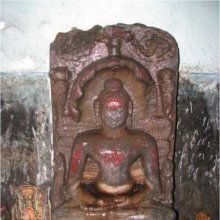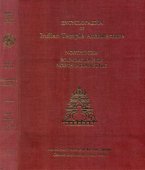Shripura, Shri-pura, Śrīpura, Śripura: 8 definitions
Introduction:
Shripura means something in Hinduism, Sanskrit, Jainism, Prakrit, the history of ancient India. If you want to know the exact meaning, history, etymology or English translation of this term then check out the descriptions on this page. Add your comment or reference to a book if you want to contribute to this summary article.
The Sanskrit terms Śrīpura and Śripura can be transliterated into English as Sripura or Shripura, using the IAST transliteration scheme (?).
Images (photo gallery)
In Hinduism
Purana and Itihasa (epic history)
Source: Cologne Digital Sanskrit Dictionaries: The Purana IndexŚripura (श्रिपुर).—(Śrīnagara) the city of Lalitā: built by Viśvakarman and Maya; in the Ṣoḍaśakṣetra madhya: Of this nine were bhauma and the seven waters: It is called Kāmeśvarīpurī, Bhayamalīpuri, Nityaklinnapuri: surrounded by Brahmā, Viṣṇu and Śiva lokas: seven prākāras, all of metal.*
- * Brahmāṇḍa-purāṇa IV. 30. 106-7; 31. 1, 106; 32. 1-10.

The Purana (पुराण, purāṇas) refers to Sanskrit literature preserving ancient India’s vast cultural history, including historical legends, religious ceremonies, various arts and sciences. The eighteen mahapuranas total over 400,000 shlokas (metrical couplets) and date to at least several centuries BCE.
Chandas (prosody, study of Sanskrit metres)
Source: Shodhganga: a concise history of Sanskrit Chanda literatureŚrīpura (श्रीपुर) refers to one of the seventy-two sama-varṇavṛtta (regular syllabo-quantitative verse) mentioned in the 334th chapter of the Agnipurāṇa. The Agnipurāṇa deals with various subjects viz. literature, poetics, grammar, architecture in its 383 chapters and deals with the entire science of prosody (e.g., the śrīpura metre) in 8 chapters (328-335) in 101 verses in total.

Chandas (छन्दस्) refers to Sanskrit prosody and represents one of the six Vedangas (auxiliary disciplines belonging to the study of the Vedas). The science of prosody (chandas-shastra) focusses on the study of the poetic meters such as the commonly known twenty-six metres mentioned by Pingalas.
In Jainism
General definition (in Jainism)
Source: archive.org: TrisastisalakapurusacaritraŚrīpura (श्रीपुर) is the name of an ancient city, according to chapter 5.4 [śāntinātha-caritra] of Hemacandra’s 11th century Triṣaṣṭiśalākāpuruṣacaritra: an ancient Sanskrit epic poem narrating the history and legends of sixty-three illustrious persons in Jainism.
Accordingly, as Śānti-nātha narrated to king Kurucandra:—“In this very Jambūdvīpa in this same zone Bhārata in the country Kosala in the city Śrīpura there were four merchants’ sons of the same age, like full brothers, Sudhana, Dhanapati, Dhanada, Dhaneśvara. Once upon a time the four together set out for Ratnadvīpa to seek a fortune. Their provisions were carried by Droṇaka. [...]”.

Jainism is an Indian religion of Dharma whose doctrine revolves around harmlessness (ahimsa) towards every living being. The two major branches (Digambara and Svetambara) of Jainism stimulate self-control (or, shramana, ‘self-reliance’) and spiritual development through a path of peace for the soul to progess to the ultimate goal.
India history and geography
Source: archive.org: Geography in Ancient Indian inscriptionsŚrīpura (श्रीपुर) is identical with modem Sirpur in Raipur district of Madhya Pradesh, about forty miles east by north from Raipur. Another Śrīpura is mentioned in Koroshanda grant of Viśākhavarman, the ruler of Kaliṅga. It may be identical with Siripurarain Viśākhapatnam district, three miles south of the Nāgāvalī river. The Bhūmikhaṇḍa of the Padma-purāṇa mentions the city as situated in Kaliṅga. The question of its connection with Sirpur about forty miles east by north from Raipur must await further discoveries for a solution.
Source: What is India: Inscriptions of the Early Gupta KingsŚrīpura (श्रीपुर).—What the capital of Kosala was in the time of Samudragupta we do not know. But about the eighth century A.D. it was certainly Śrīpura, modern Sirpur, because it was from this place that Tīvaradeva (c. 800 A.D.), who styled himself ‘Supreme Lord of Kosala’, issued two charters. Possibly Śrīpura was the capital of Kosala even in the time of the Ikṣvākus.
Source: Jainworld: Jain History (h)Śrīpura (श्रीपुर) is the historical name for Sirpur, situated in Ākolā District.—This Tīrtha is famous by the name of Antarikṣa Parśvanātha. The worship of this Antarikṣa Pārśvanātha has been mentioned in the Prākrit Nirvāṇa Kāṇḍa.
Source: What is India: Epigraphia Indica volume XXXI (1955-56)Śrīpura is mentioned in the “Aḍhabhāra plates of Mahā-Nannarāja” (c. 560 A.D.). Śrīpura, whence this grant was issued, has been identified with Sirpur in the Raipur District of Madhya Pradesh.
These copper plates (mentioning Śrīpura) were found when a cultivator named Bodhram Bhatku Teli was digging earth and were later acquired by the Deputy Commissioner of Bilaspur and presented to the Central Museum, Nagpur. It record sthe grant of a village named Kontiṇīka, situated in the viṣaya or district of Aṣṭadvāra.

The history of India traces the identification of countries, villages, towns and other regions of India, as well as mythology, zoology, royal dynasties, rulers, tribes, local festivities and traditions and regional languages. Ancient India enjoyed religious freedom and encourages the path of Dharma, a concept common to Buddhism, Hinduism, and Jainism.
Languages of India and abroad
Sanskrit dictionary
Source: Cologne Digital Sanskrit Dictionaries: Monier-Williams Sanskrit-English DictionaryŚrīpura (श्रीपुर):—[=śrī-pura] [from śrī] n. Name of a town (also ranagara), [Vetāla-pañcaviṃśatikā]
Sanskrit, also spelled संस्कृतम् (saṃskṛtam), is an ancient language of India commonly seen as the grandmother of the Indo-European language family (even English!). Closely allied with Prakrit and Pali, Sanskrit is more exhaustive in both grammar and terms and has the most extensive collection of literature in the world, greatly surpassing its sister-languages Greek and Latin.
See also (Relevant definitions)
Starts with: Shripuraka, Shripuranagara, Shripuranam.
Query error!
Full-text (+12): Haricandanavati, Kameshvaripuri, Kalayasashala, Mahaparni, Kalpakavati, Mahaphana, Mandaravati, Mahapadmatavi, Shrinagara, Samakamam, Tamrashala, Sharabhapura, Senakapat, Sudhana, Lokaprakasha, Dhanada, Dhaneshvara, Rajamarga, Trivaranagara, Dhanapati.
Relevant text
Search found 14 books and stories containing Shripura, Shri-pura, Sri-pura, Śrī-pura, Sripura, Śrīpura, Śripura; (plurals include: Shripuras, puras, Sripuras, Śrīpuras, Śripuras). You can also click to the full overview containing English textual excerpts. Below are direct links for the most relevant articles:
Jainism in Odisha (Orissa) (by Ashis Ranjan Sahoo)
Parsvanatha image at Bhandesvara Siva Temple, Shripura < [Chapter 3: Survey of Jaina Antiquities in Odisha]
Sripura (Archaeological Survey) (by Bikash Chandra Pradhan)
Meaning and Significance of the Nomenclature < [Chapter 1 - Sripura]
Location and Extent (of Sripura) < [Chapter 1 - Sripura]
Lalitopakhyana (Lalita Mahatmya) (by G.V. Tagare)
Chapter 37 - Description of other inner Apartments in the Royal Chamber
Chapter 31 - Manifestation of Seven Chambers and the daughters of Mātaṅga
Trishashti Shalaka Purusha Caritra (by Helen M. Johnson)
Part 2: Previous births of Jaya < [Chapter XIII - Jayacakricaritra]
Part 7: Śatrughna’s capture of Mathurā < [Chapter VIII - The abandonment of Sītā]
Part 14: Story of Kurucandra < [Chapter V - Twelfth incarnation as Śānti]
Notices of Sanskrit Manuscripts (by Rajendralala Mitra)
Page 50 < [Volume 9 (1888)]
Paumacariya (critical study) (by K. R. Chandra)
VII.2. Lifting up of Kotisila and selection of Hanumat for Mediation < [Chapter 3 - Comparative study of the Rama-story]
IX.2. Laksmana’s Ardhacakravartitva < [Chapter 3 - Comparative study of the Rama-story]
2. Anjanasundari and Hanumat < [Chapter 4 - Intervening Stories]
Related products

